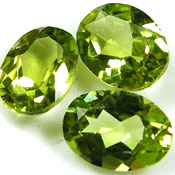Peridot
(per-i-doh)
HISTORY and LORE
- Called “Gem of the Sun” by the Egyptians. According to old legends, prospectors looked for peridot at night and located crystals by their glow. Magical attributes include power to attract wealth and drive away evil spirits.
- Name probably comes from Arabic faridat meaning gem.
- Birthstone for August. Gem for the 16th wedding anniversary.
VALUE FACTORS
- Color: Light to dark greenish yellow or yellowish green. Frequently pale “olive,” but can be bright “golden lime”.
- Clarity: Often lightly included. Minor clarity characteristics are accepted.
- Cut: Faceted in many shapes and styles. Also cabochons, fantasy cuts, and beads.
- Carat Weight: Normally available in all jewelry sizes (up to 15 or 20 carats).
TREATMENT
Peridot is among the gems for which there are no established treatments.
GEMOLOGY
- A gem variety of the olivine mineral group. Composition is somewhat variable and includes magnesium, iron, silicon, and oxygen. Color is caused by iron.
- Once called “evening emerald” because it can appear bright green in subdued light. The term is now considered a misnomer.
CARE
Peridot generally has good wearability, but protective setting is recommended.
- Hardness: Moderate scratch resistance. Rates 6.5 to 7 on the Mohs Hardness Scale.
- Toughness: Good to fair resistance to chipping and breaking (largely depending on the type and extent of clarity characteristics).
- Stability: Attacked by acids (even mild ones with long exposure). Otherwise, no routine concerns for gem owners.
- Cleaning: Detergent and water. Some liquid cleaners can cause damage. NEVER USE AN ULTRASONIC.
